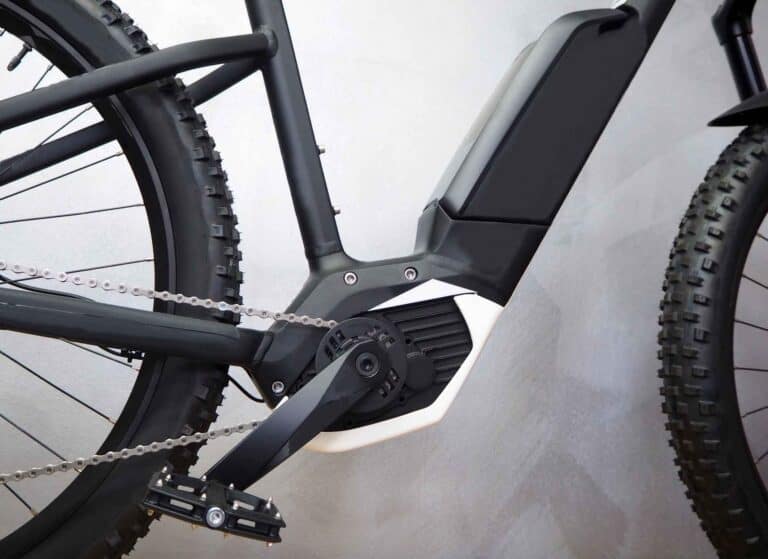Electric Bike vs. Gas Bike (An Expert Weighs Pros and Cons)
When I was looking to buy a motorized bike, I was stuck between choosing an electric bike or a gas-powered bike. I researched the differences between an electric bike and a gas-powered bike, their pros and cons, and which would make the most sense for my needs and environment. Listed below is a summary of my key findings of the differences between an electric bike and a gas bike.
As a whole, electric bikes and gas-powered bikes are both motorized bikes but differ in some aspects including, but are not limited to: cost of maintenance, running cost, lifespan, travel distance, speed, reliability, and price.
On average, electric bikes tend to be more expensive than gas bikes in new and used conditions. The most significant difference between electric bikes and gas-powered bikes is the cost. While the running cost of a gas bike fills in the price gap a bit, it’s still more expensive to own an electric bike.
As a general rule, an electric bike is the best motorized bike for beginners. Your environment and lifestyle will dictate whether you want an electric bike or a gas bike. It is important to note that gas bikes require assembly, which may not make them the best motorized bike for beginners.
Do gas bikes go faster at maximum speed than electric bikes? Are electric bikes more reliable than gas bikes? Throughout my research, these were my primary questions. I will answer these questions and many more throughout this article.
Electric Bike Vs. Gas Bike
| Lifespan | Running Cost | Cost of Maintenance | Travel distance | Speed | Reliability | Cost | |
| Electric Bike | 3-5 years before needing to replace parts | To charge, $0.14 USD/kWh (cost varies by state). | Avg. annual tune-up $150 | Avg. 25 miles/charge | Maximum speed 25 mph on avg. | Reliable when properly maintained | $1,500 USD avg. (Source) |
| Gas-Powered Bike | 3-10 years, or about 5,000-7,000 miles before needing to replace parts | Avg. gas price $2.75 USD/ gal. | Avg. Annual tune-up $150 | Avg. 100 mpg | Maximum speed 30 mph on avg. | Reliable when properly maintained | $550 USD avg. (prices compared from Amazon) |
Lifespan of Electric Bikes Vs. Gas Bikes
On average, the lifespan of both an electric bike and gas bike is about three years before needing to replace any parts, and seven years in total. After three years, you may need to replace your electric bike battery. After three years of using your gas bike, you may need to replace several parts.
For both electric and gas bikes, making sure you keep up with annual or bi-annual maintenance is critical. It is always a good idea to take your bike for a tune-up before storing it long-term or after consistent, heavy use.
To ensure you don’t have to replace any parts prematurely on your gas bike or electric bike, it is a good idea to clean it frequently. Making sure the chains are clean and lubed, storing your bike in a dry and clean space, and cleaning the frame regularly will help extend the lifespan of your gas or electric bike. To learn more about properly storing your e-bike or gas bike, check out our article on 17 electric bike storage ideas you can actually use.
Running Cost of Electric Bikes Vs. Gas Bikes
In total, it is less expensive to run an electric bike compared to a gas bike. It costs about $0.05 USD to charge an electric bike fully. To fill up the gas tank on your gas bike will cost about $3.40 when taking into account the current average gas price in the US. (Source).
While it is considerably less expensive to charge an electric bike fully, they also get much fewer miles from a full charge than a gas-powered bike with a full gas tank. On average, an electric bike gets 25 miles out of a full charge, while the average gas-powered bike can get about 100 miles from a full tank.
So, while a full charge on an electric bike may seem cheaper, if you are riding for more than 25 miles in one trip with your motor powered on, you will have to consider how many times you will need to charge your e-bike.
Another caveat with eBike charging is you will have to ensure you are riding in an area where charging stations are available. If you are riding your electric bike on a trip over 25 miles, you will not be able to take it home to charge it, so you will have to use the motor sparingly or map a route that includes a charging station.
Suppose you are interested in learning how to charge your electric bike on the road. In that case, you may be interested in checking out our article on Charging eBike on the Go (Car Battery, Inverter, Power Bank, Solar)
Before purchasing either an electric bike or a gas bike, you should run the costs of each according to the average amount of miles you imagine you will be riding each month or year.
Computing the Running Cost of an Electric Bike
To figure out the running cost of an electric bike, you will have to conduct two computations.
To compute the number of times you will have to charge your eBike in a timeframe, you should:
(X number of miles of predicted riding) / (25 miles per charge) = number of times you will need to charge your e-bike in the predicted time frame.
Then, to compute the cost of recharging in the predicted time frame, you should:
(X number of times you need to recharge your bike in the predicted time frame) x ($.05)= cost of recharging in the predicted time frame.
Computing the Running Cost of a Gas Bike
To figure out the running cost of a gas-powered bike, you will have to conduct two computations.
To compute the number of times you will have to fill your gas bike’s gas tank in a timeframe; you should:
(X number of miles of predicted riding) / (X miles per tank of gas) = number of times you will need to refill your gas tank in the predicted time frame.
Then, to compute the cost of filling your gas tank in the predicted time frame, you should:
(X number of times you will need to refuel your gas tank in the predicted time frame) x ($ cost of gas in your area per gallon)= cost of filling your gas tank in the predicted time frame.
One caveat to computing the running cost of a gas bike is the number of gallons your tank holds. Most tanks hold only 1 gallon of gas, so the computation should require you to plug in the cost per gallon. However, some gas tanks for gas bikes only hold ½ a gallon of gas, so make sure you half the price accordingly to get a more accurate running cost for the time frame of your choosing.

Cost of Maintenance on Electric Bikes Vs. Gas Bikes
On average, the cost of maintenance for both eBikes and gas bikes at the beginner level is about the same at around $150. Electric bike batteries can be very costly and will likely need to be replaced at least once. Gas bikes can be customized, so you may decide to replace a number of parts.
At most bicycle shops, the price of a tune-up is about the same regardless of bike type. The features checked during a tune-up include the standard features on any bike, like the frame, chains, gears, tires, and other critical components.
Where you might see some price differences in the cost of maintenance between electric bikes and gas bikes is the cost of maintaining the bike outside of its annual or bi-annual tune-up.
Comparatively, e-bikes are not as customizable as gas-powered bikes. Most eBikes come fully assembled or close to it. Most gas-powered bikes require assembly before riding, so the parts are easier to take on and off, thus making them easily customizable at any point during ownership. On the other hand, gas-powered bikes can require as much or as little customization as you wish.
If you are customizing your gas-powered bike, the costs can rack up fast depending on the overall expense associated with the parts you choose to customize and any potential labor costs to install those respective customizations.
Electric bike batteries can fetch a hefty price, as they average a retail price of about $350 USD. If you own an eBike, you will likely need to replace your battery at least once during its lifespan. However, as long as you ensure your electric bike is well maintained and cared for, this may be the only part you ever have to replace.
To fully understand electric bike battery costs, feel free to check out our full article on it.

Big Ticket Parts That May Need Replacing on an Electric Bike vs. Gas Bike Cost Breakdown
| Battery | Bike Chain | Gas Motor Engine | Carburetor | Tires | Total CostOn Avg. | |
| Electric Bike | $150-500 USD Avg = $325 USD | $10-$60 USD (high-end reflects price of installation) Avg = $37.50 USD Amazon Link | N/A | N/A | $25-$35 USD Avg= $30 USD Amazon Link | $392.50 |
| Gas Bike | N/A | $10-$60 USD(high-end reflects price of installation) Avg = $37.50 USD Amazon Link | $100-$230 USD Avg= $165 USD | $30-$60 USD Avg= $45 USD | $25-$35 USD Avg= $30 USD Amazon Link | $277.5 |
Travel Distance of Electric Bikes Vs. Gas Bikes
As a general rule, electric bikes can travel an average of 25 miles per charge, and gas bikes can travel about 100 miles per gallon of gas. An electric bike can go further on a single charge if you choose to turn off the motor during the ride, but a gas bike can only be used while the motor is on.
One key difference between electric bikes and gas bikes is riding with the motor off. An electric bike can be ridden like a standard bike when the motor is turned off, powered by your pedaling.
A gas bike can only be ridden with the motor turned on; therefore, you can only ride it as many miles as a tank of gas will power you.
Speed of Electric Bikes Vs. Gas Bikes
The legal speed of a motorized bike (electric and gas) under United States Federal Law is 20mph. The law states 20mph is the maximum speed your electric or gas bike can go powered by the motor alone. When combined with pedaling, you may go faster if your motorized speed does not exceed 20mph.
It is important to note that individual states have the sole power to enforce these codes, and the operation on an electric bike is governed under state law. As a result, each state can have a different speed limit for motorized bikes. Each state also has the power to set its own regulations for the use of a motorized bike.
As a result, the laws concerning motorized bikes vary widely from state to state.
The average high speed for electric bikes is 25mph. However, some can reach between 30 and 35 mph. The average high speed for gas-powered bikes is 30 mph. However, some can reach anywhere between 35-45 mph.
Since the legislation about how fast you can ride your gas or electric bikes differs by the environment in which you ride and the state in which you reside, you may want to become educated on the laws in your particular area.
For more information about the laws concerning motorized bikes in your state, feel free to check out our article: Are Electric Bikes Street Legal (Detailed Info: All 50 States)

Reliability of Electric Bikes Vs. Gas Bikes
As a general rule, electric bikes and gas bikes are reliable when purchased new. When buying a used gas or electric bike, there is no way to ensure the integrity of the electric or gas bike is the same as it may have been when it was purchased from the manufacturer.
When bought new, electric bikes and gas bikes are both very reliable. Since hitting the mainstream marketplace in the early 2010s, motorized bikes (gas and electric bikes) have become more reliable each year as they have been placed under increasing scrutiny.
As long as you keep up with maintenance, including annual or bi-annual tune-ups and frequent cleaning, there is no striking difference in the reliability of e-bikes vs. gas-powered bikes.
If your electric ride isn’t reliable, nothing else matters.
-Electric Ride Owner
Cost of Electric Bikes Vs. Gas Bikes
As a whole, electric bikes tend to be more expensive than gas bikes. The average new electric bike costs about $1,500 USD. The average new gas-powered bike costs $550 USD. New e-bikes are costly because there is little to no assembly required by the user. New gas bikes require assembly.
The price of an electric bike depends on the brand, the motor, the size, and a few other factors. The cost of a gas bike is mainly dependent on the same features. However, you will also have to buy an engine kit for your gas bike, adding more to the initial price of your purchase.
While buying a gas bike or an electric bike used may save you some money at the onset of your purchase, you may end up having to invest more in a used bike than you would in a new bike. There is no way for you as the buyer to know exactly in what condition your bike has been presented to you.
If you want to know more about the costs of electric bikes, both new and used, check out this article on how much electric bikes cost. Know that many of the caveats listed in this article apply to the costs of new and used gas bikes too, except you must take into account that gas bikes do not have batteries, but they do require engine kits.
Pros and Cons of Electric Bikes
| Pros | Cons |
| Lighter in weight than a gas bike | Targeted by bike thieves |
| Has amenities like lights, speedometer, and USB charging ports for other devices | Battery needs to be replaced after three years |
| Makes little to no sound when ridden | Spare parts can only be purchased through the manufacturer, making repairs difficult, time-consuming, and expensive |
| More environmentally friendly than a gas-powered bike and several other modes of transportation | Battery range is short (about 25-35 miles avg.) compared to a gas-powered bike’s range, averaging at about 100 miles |
Pros and Cons of Gas Bikes
| Pros | Cons |
| Lower initial cost | Must fill up the gas tank after about 100 miles |
| Higher average top speed (30mph) than the average top speed for eBikes (25mph). | More parts to install initially than an eBike (this is a con if you are a beginner, but can be a pro if you are experienced at tinkering because you can customize this bike more than an eBike) |
| Process of refueling a gas bike is much faster than the process of charging an eBike (5 minutes vs. 4-6 hours). | Some gas-powered bikes are not legal for street use, depending on your state, country, or region |
Which Is Better: Electric Bike or Gas Powered Bike?
As a general rule, whether an electric bike or a gas-powered bike is better will depend on your environment, needs, and values. After assessing what you need from a bike, what type of riding you will do, and what you value from this investment, you can decide whether a petrol or electric bike is better for you.
If you are a novice motorized bike rider looking for an environmentally friendly commute to work, an electric bike might be better for you. Electric bikes are better for people who are mainly cruising/commuting because you can only travel about 25 miles on a full charge.
This is not to say you cannot go mountain biking/off-roading with your electric bike, but there are fewer electric bikes on the market for this type of terrain than regular road cycling.
You might also prefer an electric bike if you are environmentally conscious. Aside from standard bikes, electric bikes are the next best option to reduce your carbon footprint.
If you are more of an advanced rider who enjoys racing on a motorbike track and is interested in adopting a new passion project, a petrol bike might be your best option. Petrol bikes are best for people who enjoy a project who might also like riding faster than the legal limits of most states. We recommend that you always follow the law you are governed by in your particular area of riding.
While many people with petrol bikes choose them over electric bikes because they can go faster and ride for longer, they are also perfectly equipped for road cycling if you want to use yours for your commute. Petrol bikes are an excellent choice for commuters who live in areas that do not yet have accessible charging stations, as they get 100 miles on one gallon of gas.
Petrol bikes can typically go faster than electric bikes, making them the top motorized bike choice for people who enjoy a race.
It is important to note that many towns and cities have motorways designed explicitly for racing motorized bikes.
If a petrol bike sounds more suitable for your life, but you are worried about your carbon footprint, don’t worry too much. Gas-powered bikes, while they do use gas and have a larger carbon footprint than electric bikes, are much better for the environment than a car. Any motorized bicycle replacing a vehicle is a significant contribution to lowering your carbon footprint.
Is an Electric Bike the Same as a Motorized Bike?
As a whole, electric bikes are motorized bikes. The phrase “motorized bike” is an umbrella term that describes bikes with both a motor and pedals. Motorized bikes can either be powered entirely by motor, hybrid with the motor and pedaling, or manually by pedaling.
The term “motorized bike” can be confusing, as it sounds like yet another bike option you need to consider when you are in the market to buy a bike with a motor. However, a motorized bike is just an umbrella term for a bicycle that looks like a standard bicycle with the addition of a motor.
The motor in a motorized bike can be powered in one of two ways- electrically or by gasoline. Electric bicycles and gas-powered bicycles are the only motorized bikes available at this time.
Are Motorized Bikes Worth It?
On average, motorized bike riders are generally happy with their investments and changes in lifestyle and feel that the switch was worth it. Making the switch to a motorized bike will depend on your values, environment, and financial situation at the time of your investment.
Users of motorized bikes report feeling happy with the new ease of their commutes to work, the quality of their bikes, and the significant achievement of lowering their carbon footprints. If any of these things are important to you, you may find that investing in a motorized bike is worth it.
When considering investing in a motorized bike, always keep in mind the maintenance it requires. Parts on motorized bicycles are more expensive to replace than those on standard bikes, so you need to make sure you are being responsible for the upkeep these bikes need.
Whether a motorized bike will be worth it for you is for you to decide, not me. Once you’ve done your research and compared your options in your own way, you can decide if motorized bikes are worth it.
For more things to consider when deciding between a gas bike and an electric bike, check out this video:
Do Electric Bikes Make Cycling Easier?
As a general rule, electric bikes do make cycling easier. When the motor is on, and you ride your bike with pedal assist, you do not have to pedal as much or as hard as you would on a standard bike. The motor on an electric bike is what makes the bike so easy to use.
When riding an electric bike, you do not necessarily have to use the motor to ride. When riding an electric bike, you have three options for riding. First, you can ride fully motorized, meaning you control the speed solely with a throttle, and your feet do not move on the pedals.
You can ride with pedal-assist, meaning your pedaling is assisted by the motor. Finally, you can ride with the motor turned off in manual mode.
While electric bikes make cycling easier, this does not mean you cannot use an electric bike to get a good workout. Check out our article on losing weight and maximizing your fitness by working out on your electric bike to learn more about exercising with your e-bike.






